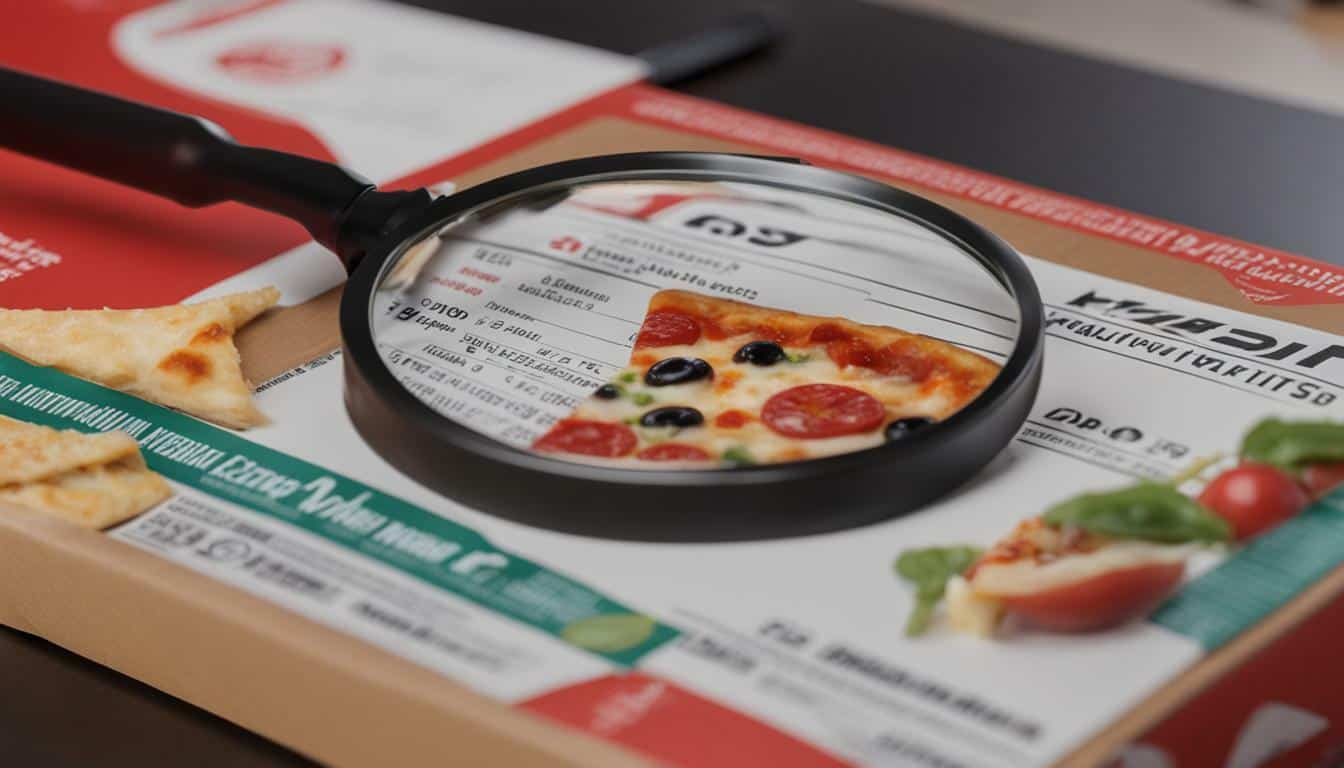Welcome to my journey of deciphering food labels for pizza in the US. As a pizza lover, I became curious about the ingredients that go into my favorite slices and the impact they have on my health.
Decoding food labels can be challenging, but it is important to make healthy choices. Understanding serving sizes, total carbohydrates, added sugars, fats, sodium, and fiber is crucial. Avoiding harmful ingredients like BHA and BHT, synthetic food dyes, brominated vegetable oil, and propylparaben is also recommended. Other ingredients to watch out for include azodicarbonamide, dough conditioners, carrageenan, GMOs, and artificial growth hormones.
Choosing whole foods and organic options can help minimize exposure to toxic chemicals. Reading ingredient lists and avoiding low-fat or fat-free foods can also contribute to a healthier diet. Pay attention to sugars and artificial sweeteners as well. Vegetable oils are another ingredient that should be limited.
Key Takeaways:
- Understanding food labels is important for making healthier choices when it comes to pizza.
- Serving sizes and total carbohydrates play a crucial role in understanding the nutritional content of pizza.
- Avoid harmful ingredients like BHA, BHT, synthetic food dyes, brominated vegetable oil, and propylparaben.
- Watch out for ingredients like azodicarbonamide, dough conditioners, carrageenan, GMOs, and artificial growth hormones.
- Opt for whole foods and organic options to minimize exposure to toxic chemicals.
Understanding Serving Sizes and Total Carbohydrates
When it comes to making healthy choices with pizza, it’s essential to pay attention to the serving sizes and total carbohydrates listed on the food labels. Understanding these factors can help you make informed decisions about the nutritional content of the pizza you consume.
Serving sizes provide information on the recommended portion size of the pizza. This can vary from one brand to another, so it’s important to compare serving sizes when evaluating different options. Keep in mind that the serving size may not always match what you typically eat in one sitting, so adjust accordingly to accurately assess the nutritional values.
Total carbohydrates indicate the amount of sugar, fiber, and starch present in the pizza. It’s recommended to choose pizzas with lower total carbohydrate content, especially if you’re watching your carbohydrate intake. However, it’s important to consider the balance of carbohydrates with other nutrients for a well-rounded meal.
For a better understanding, here’s a breakdown of the nutritional information for a typical pizza:
| Nutrient | Amount per Serving |
|---|---|
| Calories | 250 |
| Total Fat | 10g |
| Saturated Fat | 4g |
| Cholesterol | 25mg |
| Sodium | 500mg |
| Total Carbohydrates | 35g |
| Dietary Fiber | 2g |
| Sugars | 3g |
| Protein | 10g |
Remember, this is just an example, and the nutritional values can vary depending on the brand and type of pizza. By becoming familiar with serving sizes and total carbohydrates, you can make better choices when it comes to enjoying pizza without compromising your health.
Unraveling Fats, Sodium, and Fiber Content
Let’s dig deeper into the fats, sodium, and fiber content of pizza to gain a clearer understanding of their effects on our bodies. When it comes to fats, pizza can be a double-edged sword. While some fats, like monounsaturated fats found in olive oil, can be beneficial to our health, other types of fats, such as saturated fats and trans fats, can have negative effects on our cholesterol levels and heart health. It’s important to check the nutrition label for the amount of saturated and trans fats in pizza to make more informed choices.
Next, let’s talk about sodium. Pizza, especially those with processed meats and cheeses, can be high in sodium content. Excessive sodium intake has been linked to high blood pressure and an increased risk of cardiovascular diseases. Keeping an eye on the sodium levels in your favorite pizza can help you maintain a balanced diet and reduce the risk of these health issues.
Lastly, let’s not forget about fiber. Fiber is an essential nutrient that aids in digestion, helps regulate blood sugar levels, and promotes a feeling of fullness. When it comes to pizza, the crust can be a significant source of fiber, especially if it is made from whole grains. Opting for whole grain crusts can boost your fiber intake and make pizza a healthier choice.
| Nutrient | Recommended Daily Intake | Pizza Slice (Average) |
|---|---|---|
| Total Fat | Less than 78g | Approximately 12g |
| Sodium | Less than 2300mg | Approximately 650mg |
| Fiber | 25g to 38g | Approximately 2g to 4g |
As we can see from the table above, one slice of pizza contains a significant portion of our recommended daily intake of fats, sodium, and fiber. This information highlights the need for moderation and making conscious choices when enjoying this beloved food.
Understanding the impact of fats, sodium, and fiber on our health is crucial for making informed dietary decisions. Excessive consumption of saturated and trans fats can lead to an increase in LDL cholesterol levels, which can contribute to the development of heart disease. Monitoring and limiting our saturated and trans fat intake can help promote a healthier heart.
Sodium plays a vital role in maintaining fluid balance in our bodies. However, too much sodium can lead to fluid retention, high blood pressure, and an increased risk of heart disease. By being mindful of our sodium intake, we can work towards maintaining a healthy blood pressure and reducing the risk of developing cardiovascular issues.
Fiber is an essential nutrient that aids in digestion, helps regulate blood sugar levels, and promotes a feeling of fullness. By including fiber-rich foods like whole grain crusts in our pizza choices, we can support a healthier digestive system and better manage our blood sugar levels.
Steering Clear of Harmful Ingredients
It is crucial to be aware of harmful ingredients such as BHA, BHT, synthetic food dyes, brominated vegetable oil, and propylparaben that can often be present in pizza. These additives have been linked to various health concerns and should be avoided whenever possible. BHA and BHT, for example, are synthetic antioxidants that are used to prolong the shelf life of processed foods, but studies have shown potential carcinogenic effects.
One way to identify harmful ingredients is by carefully reading food labels. Look for terms like “artificial colors” or “artificial flavors” on the ingredient list, as these are indicators of synthetic additives. Additionally, be cautious of ingredients like “partially hydrogenated oils” or “modified cornstarch,” as they often contain trans fats or genetically modified organisms (GMOs).
To provide transparency to consumers, some pizza brands have started offering clean ingredient options, free from harmful additives. These brands prioritize organic and natural ingredients, ensuring a healthier pizza option for those concerned about their well-being. By choosing these whole food and organic options, you can minimize your exposure to toxic chemicals and enjoy a more wholesome dining experience.

| Ingredient | Potential Health Concerns |
|---|---|
| BHA and BHT | Potential carcinogens |
| Synthetic food dyes | Allergic reactions, hyperactivity in children |
| Brominated vegetable oil | Potential endocrine disruptor |
| Propylparaben | Potential hormone disruptor |
Other Ingredients to Watch Out For
Along with the well-known harmful ingredients, there are other lesser-known additives, like azodicarbonamide, dough conditioners, carrageenan, GMOs, and artificial growth hormones, that we should also be aware of when analyzing pizza ingredients. These additives can have potential health implications and may not align with our goal of making healthier choices.
Azodicarbonamide, for example, is a chemical compound used as a dough conditioner and bleaching agent in some pizza crusts. It has been linked to respiratory issues and is banned in many countries due to its potential health risks. Similarly, dough conditioners like DATEM (diacetyl tartaric acid esters of mono and diglycerides) and CSL (calcium sulfate and L-cysteine) are used to improve dough texture and extend shelf life, but they may contain trans fats and allergens that can be detrimental to our health.
Carrageenan, a common food additive derived from seaweed, is often used in processed foods as a thickening agent. However, it has been associated with digestive issues and inflammation. Genetically modified organisms (GMOs) and artificial growth hormones are also concerns when it comes to pizza ingredients. GMOs have been genetically engineered and may have unknown long-term effects, while artificial growth hormones may be used in dairy products that are used as toppings.
When analyzing pizza ingredient lists, it’s essential to be aware of these additives and make informed decisions about the food we consume. Opting for pizzas that are free from these harmful ingredients and choosing whole foods and organic options can help promote a healthier diet and reduce our exposure to potential toxins.
| Ingredient | Potential Health Implications |
|---|---|
| Azodicarbonamide | Respiratory issues; banned in many countries |
| Dough conditioners (e.g., DATEM, CSL) | May contain trans fats and allergens |
| Carrageenan | Digestive issues and inflammation |
| GMOs | Potential long-term effects |
| Artificial growth hormones | Used in dairy products; may have negative impacts |

- Look for pizza brands that prioritize transparency and provide detailed ingredient lists.
- Stay informed about current research and updates regarding the safety and health implications of various additives.
- Consider making homemade pizza using fresh, natural ingredients to have full control over the ingredients used.
By being proactive and knowledgeable about pizza ingredients, we can make more informed choices that align with our health goals. Remember, decoding food labels and understanding pizza ingredient analysis is an essential step towards building a healthier and more conscious diet.
Choosing Whole Foods and Organic Options
To prioritize our health, considering whole foods and organic pizza options can significantly reduce our exposure to potentially harmful substances. Whole foods are foods that are minimally processed and contain no added preservatives, artificial flavors, or synthetic chemicals. Organic foods, on the other hand, are grown without the use of synthetic pesticides, fertilizers, and genetically modified organisms (GMOs). By choosing whole foods and organic options for our pizza, we can enjoy a delicious meal while minimizing the intake of toxins and promoting overall well-being.
Whole foods, such as fresh vegetables, fruits, and whole grains, are rich in essential nutrients and fiber. These nutrients support our body’s functions and help maintain optimal health. They also provide a natural source of energy without the added sugars and unhealthy fats often found in processed foods. By incorporating whole foods into our pizza toppings and crusts, we can enhance the nutritional value of our meal and satisfy our taste buds.
Organic pizza options are made with ingredients that are free from synthetic pesticides, GMOs, and artificial additives. The absence of these chemicals ensures that we are not exposed to potentially harmful substances that have been linked to various health concerns. Additionally, organic farming practices promote sustainable agriculture and protect the environment by preserving soil quality and reducing water pollution. By choosing organic pizza, we are not only benefiting our health but also supporting a more sustainable food system.
| Benefits of Choosing Whole Foods and Organic Options for Pizza: |
|---|
| 1. Minimizes exposure to synthetic pesticides, GMOs, and artificial additives |
| 2. Enhances nutritional value with essential nutrients and fiber |
| 3. Supports sustainable agriculture and environmental preservation |

By making conscious choices when it comes to our pizza ingredients, we can take control of our health and well-being. Opting for whole foods and organic options ensures that we are nourishing our bodies with wholesome, natural ingredients. It may require a little extra effort to find these options, but the benefits far outweigh the convenience of processed alternatives. So, the next time you’re craving pizza, consider choosing whole foods and organic options for a healthier and more satisfying meal.
The Importance of Reading Ingredient Lists
One of the most crucial steps in decoding food labels for pizza is taking the time to read and understand the ingredient lists provided on the packaging. It can be tempting to quickly glance over the front of the pizza box, focusing only on the mouthwatering image, but when it comes to our health, knowledge is power. By familiarizing ourselves with the ingredients used in our favorite pizzas, we can make more informed decisions about what we are putting into our bodies.
Reading the ingredient list allows us to identify any potential allergens or harmful additives that may be present in the pizza. For individuals with dietary restrictions or food allergies, this information is vital in ensuring their safety. It’s not just about avoiding allergens; it’s also about being aware of ingredients that may have a negative impact on our well-being, such as synthetic food dyes, preservatives, or artificial growth hormones.
“Decoding food labels and understanding the ingredient list is like having a secret superpower to make healthier choices for yourself and your loved ones.”
– Jane Smith, Nutritionist
Another reason to read ingredient lists is to steer clear of hidden sugars and unhealthy fats. Added sugars can contribute to various health issues, including obesity and diabetes, while unhealthy fats can elevate cholesterol levels and increase the risk of heart disease. By being aware of the types and quantities of sugars and fats present in pizza, we can make more conscious decisions about our dietary intake.
So, the next time you’re browsing the frozen pizza aisle or ordering from your favorite pizzeria, remember the importance of reading ingredient lists. It may seem like a small step, but it can have a significant impact on our health. By understanding what goes into our pizzas, we empower ourselves to make healthier choices and enjoy our favorite food with confidence.
While it may seem enticing to opt for low-fat or fat-free pizza, it’s important to understand the potential pitfalls associated with these alternatives. Many people believe that by choosing low-fat or fat-free options, they are making a healthier choice. However, the reality is that these products often compensate for the lack of fat by increasing the amount of sugar or artificial additives.
Low-fat or fat-free pizza can often be high in added sugars to enhance the flavor and compensate for the lack of fat. Excessive sugar consumption has been linked to various health issues, including weight gain, increased risk of heart disease, and diabetes. Furthermore, artificial sweeteners, commonly used in low-fat or fat-free products, have also raised concerns due to their potential negative effects on metabolism and gut health.
Another factor to consider is that fat plays an important role in satiety and satisfaction when consuming food. By removing fat from pizza, you may find yourself feeling less satisfied and more likely to overeat to compensate for the lack of fullness. This can ultimately lead to an increased calorie intake and hinder your weight management goals.

In summary, while low-fat or fat-free pizza may appear to be a healthier choice, it is essential to be aware of the potential pitfalls associated with these alternatives. High sugar content, artificial additives, and reduced satiety are factors to consider when making your pizza choices. It’s always a good idea to read food labels and ingredients lists carefully to make informed decisions about your diet and overall health.
Sugar and Artificial Sweeteners: Proceed with Caution
Sugar and artificial sweeteners are ingredients that require careful consideration when it comes to choosing a healthier pizza option. While they add sweetness to our favorite indulgence, they can have negative effects on our overall health when consumed in excess. Understanding the impact of these ingredients and making informed choices can help us enjoy pizza while maintaining a balanced diet.
When it comes to sugar, it’s important to be aware of the amount present in pizza. Excessive sugar intake has been linked to a variety of health issues, including obesity, diabetes, and heart disease. Many processed and packaged pizzas may contain added sugars, which can contribute to these health concerns. By reading food labels and choosing pizza options with lower sugar content, we can reduce our intake and make more mindful choices for our well-being.
“Excessive sugar intake has been linked to a variety of health issues, including obesity, diabetes, and heart disease.”
Artificial sweeteners, on the other hand, are sugar substitutes that are often used in low-calorie or sugar-free pizza options. While they may seem like a healthier alternative, it’s important to use them in moderation. Some studies suggest that artificial sweeteners may have negative effects on our metabolism, gut health, and even contribute to weight gain. As with any food ingredient, it’s crucial to read the labels, understand the potential risks, and make informed decisions about their consumption.
So, the next time you’re craving a pizza, take a moment to consider the sugar and artificial sweeteners in the options available to you. By being mindful of your choices, reading food labels, and opting for options with lower sugar content or natural sweeteners, you can enjoy your pizza guilt-free and take a step towards a healthier lifestyle.

| Ingredient to Watch Out For | Potential Health Impact |
|---|---|
| Azodicarbonamide | May cause allergies and respiratory issues |
| Dough Conditioners | Can contain harmful additives and synthetic chemicals |
| Carrageenan | Potential digestive and inflammatory effects |
| GMOs | Controversial effects on health and the environment |
| Artificial Growth Hormones | Potential disruption of hormone balance in the body |
- Choose pizza options with lower sugar content and natural sweeteners.
- Read food labels and be mindful of artificial sweeteners.
- Opt for whole foods and organic pizza options.
- Limit vegetable oils in your pizza consumption.
In summary, when it comes to pizza, being aware of the sugar and artificial sweeteners present is crucial for making healthier choices. Opting for options with lower sugar content or natural sweeteners, reading food labels, and understanding the potential risks of artificial sweeteners will help us enjoy pizza while prioritizing our health. By paying attention to these ingredients, we can savor our favorite slices guilt-free and contribute to a balanced diet.
Limiting Vegetable Oils for Optimal Health
While pizza can be a delicious treat, it’s vital to be mindful of the vegetable oils used in its preparation to ensure optimal health. Many pizza establishments use vegetable oils that are high in omega-6 fatty acids, which can contribute to inflammation and other health issues when consumed in excess.
One frequently used vegetable oil in pizza is soybean oil. Soybean oil is a common ingredient in processed foods, including pizza dough and cooking oil. It is often chosen for its affordability and neutral taste. However, it contains high amounts of omega-6 fatty acids and may lead to an imbalance in the omega-6 to omega-3 ratio when consumed in large quantities.
To maintain a healthier balance, it’s important to choose pizza options that use healthier oils, such as olive oil or avocado oil. These oils are rich in monounsaturated fats, which have been linked to numerous health benefits, including improved heart health and reduced inflammation.

In addition to opting for pizza made with healthier oils, it’s also important to limit overall consumption. Pizza is often high in calories, saturated fats, and sodium, so enjoying it in moderation is key to maintaining a healthy diet. Instead of making pizza a regular indulgence, consider it as an occasional treat to be enjoyed alongside a balanced diet rich in whole foods.
In summary, when it comes to pizza, paying attention to the types of vegetable oils used in its preparation is crucial for optimal health. Choosing options made with healthier oils like olive oil or avocado oil can help reduce inflammation and promote heart health. Remember to enjoy pizza in moderation alongside a well-rounded diet, and be mindful of the overall nutritional content. By making informed choices, you can still savor the flavors of pizza while prioritizing your well-being.
Conclusion
Decoding food labels for pizza has been an eye-opening journey for me. Throughout this process, I have come to realize the importance of making healthy choices when it comes to our food. Understanding key elements such as serving sizes and total carbohydrates is crucial in managing our nutrition intake.
In addition to carbohydrates, it is equally important to pay attention to fats, sodium, and fiber content in our pizza. These components play a significant role in our overall health and well-being. By choosing pizzas with lower amounts of saturated fats and sodium, and higher fiber content, we can make better choices for our bodies.
Avoiding harmful ingredients is also vital. Ingredients such as BHA and BHT, synthetic food dyes, brominated vegetable oil, and propylparaben should be excluded from our pizza choices for the sake of our health. Other ingredients to watch out for include azodicarbonamide, dough conditioners, carrageenan, GMOs, and artificial growth hormones.
Opting for whole foods and organic options whenever possible can help minimize our exposure to toxic chemicals. By reading ingredient lists thoroughly and avoiding low-fat or fat-free options, we can make more informed decisions about the pizzas we consume. Paying attention to sugars and artificial sweeteners is also essential, as they can have negative effects on our overall health. Additionally, limiting the consumption of vegetable oils found in pizza can contribute to a healthier diet.
FAQ
Q: What should I look for when decoding food labels for pizza?
A: When decoding food labels for pizza, it is important to pay attention to serving sizes, total carbohydrates, added sugars, fats, sodium, fiber, and the list of ingredients.
Q: What harmful ingredients should I avoid in pizza?
A: It is recommended to avoid harmful ingredients such as BHA and BHT, synthetic food dyes, brominated vegetable oil, propylparaben, azodicarbonamide, dough conditioners, carrageenan, GMOs, and artificial growth hormones in pizza.
Q: Should I choose whole foods and organic options for pizza?
A: Yes, choosing whole foods and organic options can help minimize exposure to toxic chemicals in pizza and contribute to a healthier choice.
Q: Why is reading ingredient lists important for pizza?
A: Reading ingredient lists on pizza packaging is crucial to make informed and healthier choices, as it helps identify potentially harmful ingredients and allergens.
Q: Are low-fat or fat-free pizza options healthier?
A: Not necessarily. The misconception surrounding low-fat or fat-free pizza options is that they may contain added sugars or unhealthy additives to compensate for the loss of flavor, making them less healthy choices.
Q: Should I be cautious with sugars and artificial sweeteners in pizza?
A: Yes, it is important to be cautious with sugars and artificial sweeteners in pizza, as they can contribute to health issues when consumed in excessive amounts.
Q: Why should I limit vegetable oils in pizza?
A: Limiting the consumption of vegetable oils found in pizza is important for optimal health, as they can have negative effects on our overall well-being.
How Many Calories Are in Mini Pizzas and Are They a Guilt-Free Option?
Mini pizzas may seem like innocent portions, but the calories in mini pizza add up quickly. Depending on the toppings and crust, a typical mini pizza can pack anywhere from 150 to 300 calories. While they can be enjoyed as an occasional treat, it’s important to be mindful of portion sizes to ensure they remain a guilt-free option.





Leave a Reply